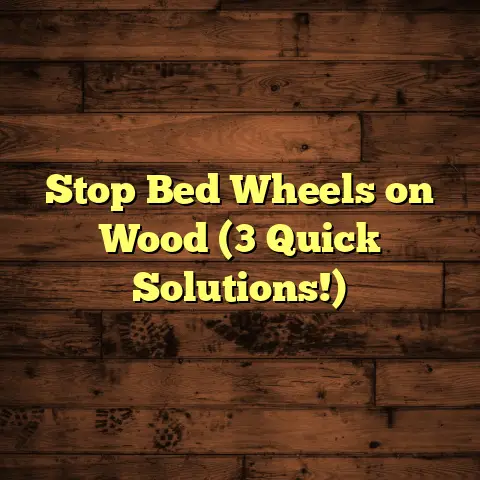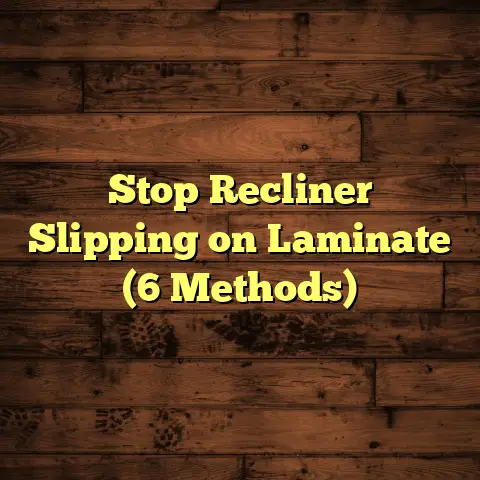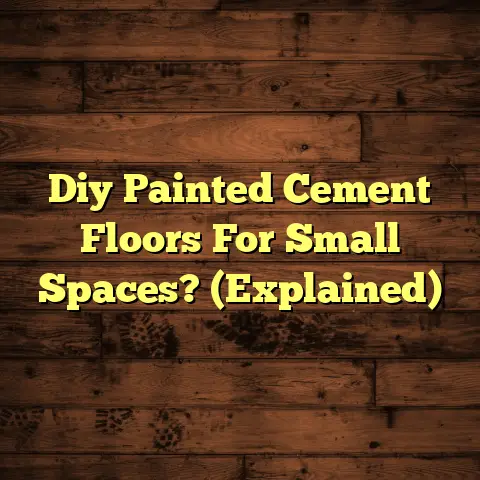Shine Back To Wood Floors: How To? (1 Stain Secret!)
And let me tell you, nothing beats the warmth and elegance of beautifully maintained wood floors.
But in today’s smart homes, where technology reigns supreme, keeping those floors looking their best can feel like a real challenge.
Let’s dive into how to bring back that lost shine!
Introduction: The Age of Smart Homes and Their Flooring Needs
Smart homes are all the rage, right? We’re talking about everything from lights that dim on command to thermostats that learn your schedule. It’s all about convenience, efficiency, and making life a little easier.
But amidst all this tech, we can’t forget about the foundation of our homes – literally! Flooring plays a huge role in the overall vibe of a smart home.
It’s not just about looking good; it’s about feeling comfortable, creating a welcoming atmosphere, and complementing the smart features we love.
Wood floors, with their timeless beauty and durability, remain a top choice. But here’s the kicker: smart homes often introduce new challenges for wood floor maintenance.
Think about it: robotic vacuums bumping around, humidity-controlled environments, and even the types of cleaning products we use.
All of these factors can impact the health and shine of your wood floors. So, how do we keep them looking their best in this tech-savvy world? Let’s explore!
Section 1: Understanding Wood Floors
Okay, before we get into the nitty-gritty of restoring shine, let’s talk wood! Not all wood floors are created equal.
Knowing what type you have is crucial for proper care.
Types of Wood Flooring
-
Solid Hardwood: This is the real deal – planks made from a single piece of wood. It’s durable, beautiful, and can be refinished multiple times. Think oak, maple, and cherry. It’s a classic choice, but can be sensitive to humidity changes.
-
Engineered Wood: This consists of a thin layer of real wood (the veneer) bonded to a core of plywood or high-density fiberboard. It’s more stable than solid hardwood, making it a good option for basements or areas with fluctuating humidity.
-
Laminate: This is a synthetic flooring that mimics the look of wood. It’s affordable, durable, and easy to install, but it’s not real wood and can’t be refinished.
-
Bamboo: Technically a grass, bamboo flooring is eco-friendly and durable. It’s a sustainable option that can add a unique look to your smart home.
Here’s a quick table summarizing the key differences:
| Feature | Solid Hardwood | Engineered Wood | Laminate | Bamboo |
|---|---|---|---|---|
| Material | Solid Wood | Wood Veneer | Synthetic | Bamboo Grass |
| Refinishable | Yes | Limited | No | Limited |
| Humidity Resist | Low | Medium | High | Medium |
| Cost | High | Medium | Low | Medium |
Common Issues with Wood Floors
Now, let’s face it: wood floors aren’t invincible. They’re prone to a few common problems:
-
Scratches: These are inevitable, especially if you have pets or kids. Even small scratches can dull the overall appearance of your floors.
-
Dents: Dropping heavy objects can leave dents that are difficult to repair.
-
Fading: Sunlight can cause wood floors to fade over time, especially if they’re not properly protected.
-
Dullness: This is the big one we’re tackling today! Dullness can be caused by a buildup of dirt, grime, and worn-out finish.
Environmental factors like humidity and temperature fluctuations, along with foot traffic and improper cleaning methods, can all contribute to these issues.
Section 2: The Importance of Regular Maintenance
Think of your wood floors like a car: you need to maintain them regularly to keep them running (and looking) their best.
Routine Care
-
Sweeping: Sweep your wood floors at least once a week to remove loose dirt and debris.
I recommend using a soft-bristled broom or a microfiber dust mop.
-
Vacuuming: Vacuuming is great for getting into corners and removing embedded dirt. Use a vacuum with a soft brush attachment to avoid scratching the floor.
-
Mopping: Mopping is essential for removing grime and restoring shine. Use a wood floor cleaner specifically designed for your type of finish. Avoid using too much water, as it can damage the wood.
I’ve seen so many floors ruined by over-wet mopping!
Neglecting these tasks can lead to a buildup of dirt and grime, which can scratch the finish and dull the overall appearance of your floors.
Seasonal Maintenance
Did you know that changes in humidity and temperature can affect your wood floors? In the winter, when the air is dry, wood floors can shrink and crack. In the summer, when the air is humid, they can expand and warp.
Here are a few seasonal maintenance tips:
-
Winter: Use a humidifier to maintain a consistent humidity level in your home. This will help prevent your wood floors from drying out and cracking.
-
Summer: Use air conditioning to keep your home cool and dry. This will help prevent your wood floors from expanding and warping.
-
All Seasons: Use curtains or blinds to protect your wood floors from direct sunlight. This will help prevent fading.
Section 3: The Shine Factor
Let’s talk about shine! Why is it so important?
Why Shine Matters
Shiny wood floors can transform a room, making it look brighter, cleaner, and more inviting. They also add value to your home.
Think about it: when you walk into a house with gleaming wood floors, it instantly creates a positive impression. It shows that the homeowner cares about their property and takes pride in its appearance.
The Science of Shine
The shine of your wood floors depends on the finish. There are three main types of finishes:
-
Oil-Based Finishes: These finishes provide a durable, water-resistant surface with a warm, amber hue. They tend to have a higher VOC (volatile organic compound) content.
-
Water-Based Finishes: These finishes are more environmentally friendly than oil-based finishes and dry faster. They provide a clear, durable finish that doesn’t yellow over time.
-
Wax Finishes: These finishes provide a soft, natural shine. They’re easy to apply and maintain, but they’re not as durable as oil-based or water-based finishes.
The right finish can protect the wood while enhancing its natural beauty. When the finish is worn or damaged, it can lose its shine and make the floors look dull.
Section 4: The Stain Secret
Alright, here’s the moment you’ve been waiting for: the stain secret!
The One Stain Secret
Okay, it’s not exactly a stain, but rather a tinted polyurethane finish!
Here’s the deal: sometimes, your floors are just a little worn, not completely trashed. Instead of a full sand and refinish, a tinted polyurethane can add a hint of color while also adding a protective layer.
The secret? Use a high-quality polyurethane finish with a very subtle tint that complements your existing floor color.
This is how you can choose the right stain:
-
Wood Type: Consider the type of wood. Oak, maple, and cherry all react differently to stains.
-
Existing Finish: Choose a stain that complements the existing finish. If you’re not sure what type of finish you have, test a small area with a few different stains.
-
Desired Look: Do you want to enhance the natural color of the wood, or do you want to change it completely?
Step-by-Step Guide to Application
Okay, let’s get down to business. Here’s a step-by-step guide on how to apply the tinted polyurethane:
-
Gather Your Supplies: You’ll need:
- Tinted Polyurethane Finish
- Fine-grit Sandpaper (220 grit)
- Tack Cloth
- Paint Tray
- High-Quality Brush or Foam Applicator
- Safety Glasses
- Gloves
- Respirator
-
Prepare the Floor:
-
Thoroughly clean the floor with a wood floor cleaner.
- Lightly sand the floor with fine-grit sandpaper to roughen the surface.
- Remove all dust with a tack cloth.
-
Apply the Finish:
-
Pour a small amount of tinted polyurethane into the paint tray.
- Apply a thin, even coat of finish to the floor, working in the direction of the wood grain.
- Avoid applying too much finish, as it can cause drips and runs.
-
Let It Dry:
-
Allow the finish to dry completely according to the manufacturer’s instructions. This usually takes 24-48 hours.
-
Apply a Second Coat (Optional):
-
If you want a more durable finish, you can apply a second coat of tinted polyurethane.
- Lightly sand the floor with fine-grit sandpaper before applying the second coat.
Safety Precautions:
- Always wear safety glasses, gloves, and a respirator when working with polyurethane.
- Work in a well-ventilated area.
- Keep children and pets away from the work area.
Section 5: Additional Techniques for Restoring Shine
The tinted polyurethane is a great trick, but let’s explore some other ways to get your floors gleaming!
Natural Remedies
Believe it or not, you can use natural ingredients to enhance the shine of your wood floors. Here are a few recipes:
-
Vinegar and Water: Mix 1/2 cup of white vinegar with 1 gallon of warm water. Mop the floor with the solution, and then dry it with a clean cloth.
-
Olive Oil and Lemon Juice: Mix 1/4 cup of olive oil with 1/4 cup of lemon juice. Apply the solution to the floor with a soft cloth, and then buff it with a clean, dry cloth.
-
Essential Oils: Add a few drops of your favorite essential oil (like lemon or lavender) to your wood floor cleaner. This will add a pleasant scent and help to disinfect the floor.
Professional Solutions
Sometimes, DIY methods just aren’t enough. If your wood floors are severely damaged or dull, it might be time to call in the pros.
-
Refinishing: This involves sanding down the old finish and applying a new one. It’s a more expensive option, but it can completely transform your floors.
-
Polishing: This involves applying a polishing compound to the floor to restore its shine. It’s a less expensive option than refinishing, but it’s not as effective for severely damaged floors.
The cost of professional refinishing or polishing can vary depending on the size of your home, the type of wood, and the condition of the floors.
According to HomeAdvisor, the average cost to refinish wood floors is between \$3 and \$8 per square foot.
Section 6: Preventive Measures for Long-Lasting Shine
Okay, we’ve talked about restoring shine, but let’s focus on prevention!
Protective Measures
-
Area Rugs: Place area rugs in high-traffic areas to protect the floors from scratches and wear.
-
Furniture Pads: Use furniture pads under the legs of your furniture to prevent dents and scratches.
-
Avoid Shoes: Encourage family members and guests to remove their shoes before entering the house.
Smart Technology Integration
Guess what? Your smart home tech can actually help with floor care!
-
Smart Vacuums: Schedule your smart vacuum to clean your wood floors regularly.
-
Automated Cleaning Schedules: Set up reminders on your smart home system to sweep and mop your floors regularly.
-
Humidity Control Systems: Use a smart thermostat with humidity control to maintain a consistent humidity level in your home.
Conclusion: Embracing the Future with Shiny Wood Floors
So, there you have it! Maintaining shiny wood floors in a smart home is totally achievable. By understanding your floors, implementing regular maintenance, and using the right techniques (including that stain secret!), you can keep your floors looking their best for years to come.
Remember, wood floors are an investment, and with proper care, they can remain a stunning centerpiece in any modern home. Now go forth and make those floors shine!





